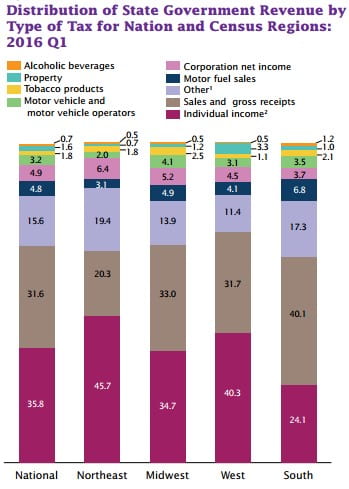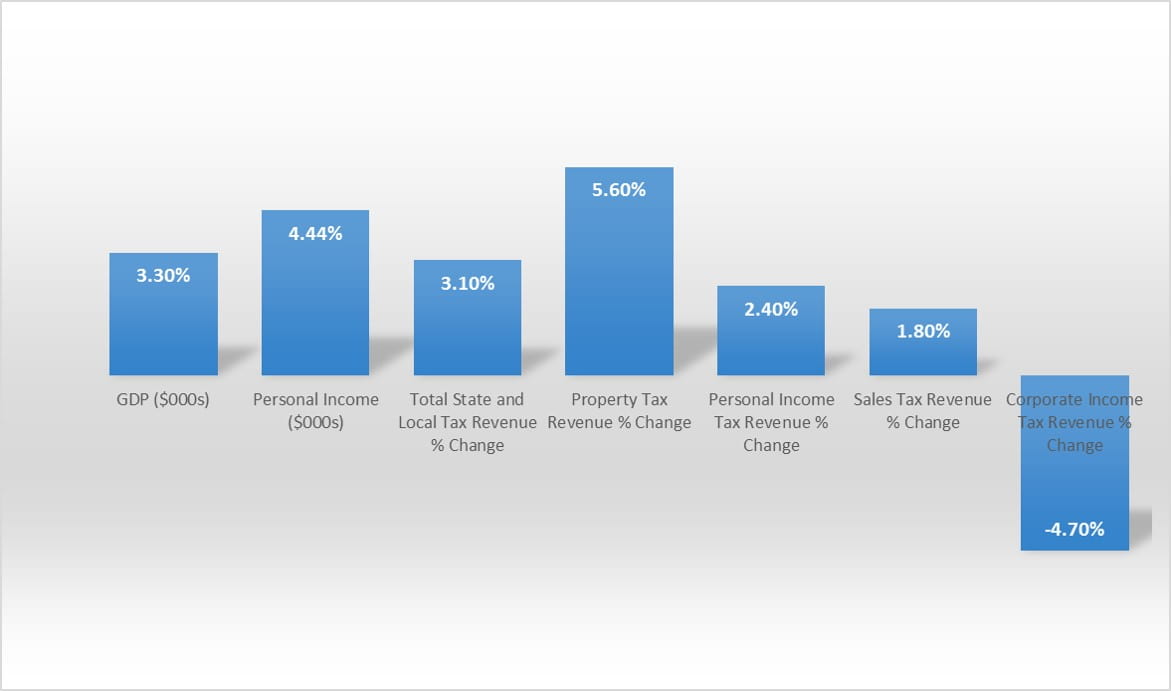First Quarter of 2016 Sees Tax Revenues Rise 3.1% Since Same Time Last Year
The amount of tax revenues being brought in by state and local governments is important, as it may indicate the direction of the economy through increased economic activity, it may reflect changes in tax rates, or it may be due to increased effectiveness on the part of state and local governments in collecting revenues. It also is an indication of how much funding is available for government functions and policies. If revenues are trending downward, it could be a sign of a declining economic base, and a harbinger of future service cuts. Ideally, it would simply reflect that governments have managed to maintain quality services with lower revenue requirements, but lower revenues are more likely due to current or future economic issues.
Increasing revenues by contrast are not necessarily a positive. If revenue growth is outpacing GDP growth and changes in personal income and consumption numbers, it could be a sign of increased tax rates. Increased taxation may indicate increased services, but could also be a sign of fiscal mismanagement and the need for additional revenues to close budget deficits. However, unless tax revenue increases are caused by tax rate increases, more government revenue is typically a sign of growth and prosperity.
Increased Revenues
The U.S. Census Bureau released their quarterly summary of state and local government tax revenue for the first quarter of 2016. The four largest tax categories, property taxes, sales taxes, and corporate and individual income taxes, increased a total 3.1% from Q1 2015 to Q1 2016, bringing in $317 billion in 2016, up from $307.4 billion in 2015. The graph below from the Census Bureau reflects the changes in each category as well as the total change.
The largest growth category came from state and local property taxes, which increased 5.6% from Q1 2015 to Q1 2016, bringing in $119 billion and $125.7 billion, respectively. Property tax is the primary funding source for local governments. $122.1 billion of those revenues collected in Q1 2016 were for local governments, with only $3.6 billion going to state coffers.
State governments are primarily funded by tax revenues from individual income taxes and sales tax receipts. Individual income tax revenues increased at a rate of 2.4%, from $86.6 billion in Q1 2015 to $88.7 billion in Q1 2016. Sales tax revenues also increased albeit more slowly, from $87.8 billion in Q1 2015 to $89.4 billion in Q1 2016, a rate of 1.8%. Corporate income tax revenues were the only ‘big four’ category to decline, with revenues down 4.7%, from $13.9 billion in Q1 2015 to $13.2 billion in 2016.
The Census Bureau has provided a very interesting chart showing the breakdown of state government tax revenues by tax type, for the nation overall as well as the four official Census Regions. Sales taxes and personal income taxes make up the two largest revenue generators for each region, but to varying degrees. For example, the Northeast states generate nearly twice as much revenue as a percentage of overall taxes from individual income taxes as the Southern states, but rely half as much on sales taxes as the South.
How Does That Make You Feel?
So, is all this revenue growth good or bad? That is a question we cannot definitively answer, but as stated above, if these increases match up with general signs of economic growth, then they are more likely to be healthy boons to state and local governments, which they can then use to either expand or improve services, or improve their financial condition.
Deciding which metrics to compare the big four revenue categories to isn’t an exercise in apples-to-apples comparisons. The best options of publicly available data come from the U.S. Bureau of Economic Analysis (BEA), in the form of Gross Domestic Product (GDP) and Personal Income. The BEA defines GDP as the measure of the market value of all final goods and services within a specific jurisdiction over a specific term. Personal Income is defined by the BEA as the income that persons receive in return for their provision of labor, land, and capital used in current production as well as other income, such as personal current transfer receipts.
Personal income changes match up to changes in personal income taxes quite nicely, and to a lesser degree for corporate income taxes. However, corporate income taxes do not match up quite as well, as different factors affect corporate earnings. A tighter labor market may equate to rising incomes, but rising incomes may affect corporate profitability, states and cities may be dropping corporate tax rates in the ongoing competition to appear ‘business friendly’, or many other factors could be at play.
The BEA also measures Personal Consumption, which it defines as the measure of spending on goods and services purchased by households in a given jurisdiction. Personal consumption would be a good metric to compare against sales tax receipts, but the BEA does not have data available yet for 2015 or 2016.
Property taxes are based upon assessments that take place at different timeframes for different jurisdictions. Therefore, property values and tax receipts can often lag current economic conditions, and are more smoothed out and stable than other revenue sources. Overall, while personal income and personal income taxes are the best metrics for comparison, a general comparison of all four tax categories to GDP and personal income changes has value.
MuniNet collected the BEA data on GDP and Personal Income for State and Local Governments and calculated the percentage changes from Q1 of 2015 to Q1 of 2016. You can see the changes and how they ranked against each of the big four revenue metrics, as well as total state and local government revenue. If you are someone who is typically up on the latest reported national figures for GDP and Personal Income, you will notice that the numbers below differ from what is typically reported as the national GDP and Personal Income changes. We used the BEA’s regional numbers, which collects data within the individual states and totals them. The figures that are typically reported in the media as the national figures include overseas activity and federal expenditures. As such, numberslow are smaller than the true national totals, but are a better reflection of activity within the states, and therefore a better comparison to state and local government revenues.
Total % Change in Economic Metrics and State and Local Tax Revenue Sources Q1 2015-Q1 2016
As you can see, overall GDP growth paced fairly evenly with total state and local government tax revenue growth over this period. In fact, GDP and personal income growth both outpaced each revenue metric, with the exception of property taxes. While this doesn’t mean we can say for certain that increased tax revenues are a good thing, the numbers do lend evidence to the assumption that this revenue growth is a healthy and organic reflection of an improving economy. It is up to policy makers to ensure that the additional funds are utilized responsibly.
by Jeffrey L Garceau




